FAQ - Ski Touring and Snow Camping
Send any comments to the maintainer Roger Caffin
There are two main things to note about ski-touring: the scenery is fantastically different, and there is a whole new set of hazards. On a fine day the High Plains can be just beautiful, and you can look forever. Our apologies if this page takes a little longer to download: there are so many pictures worth showing!
Contributions
We would love to have contributions from other ski-touring enthusiasts: it would help balance a few blatant biases (Yes, you can wear DVs and KTs in the snow). Paul Davis has contributed a gear list he wrote: I have left it at his web site. Princton University in America have a 'how to' web page on winter trips and snow camping, meant I suspect for new undergraduates but with a lot of information. Any more?
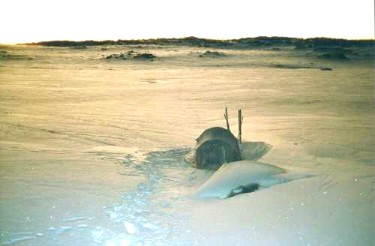
In Praise of Snow Camping
We leave you to find out about the scenery and the photographic challenges it brings for yourself. Here we cover some of the hazards and ways of handling them. On which subject, K A Moylan wrote very eloquently:
Snow camping is hard work. I can't recall how long I've had to spend digging snow walls to shelter our flimsy tent from being blown away, and even then it got buried in snow, before it got warmer & all the snow was melted away. And if you dig a snow cave, it is always below freezing, for as soon as it gets warmer than that, water trickles into everything, getting the sleeping bags wet & seeping into the 2 minute noodles (which is all we can carry, as everything else is too heavy). Now cold, dry 2 minute noodles are OK, but cold soggy 2 minute noodles are just mush.
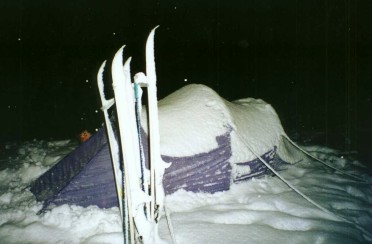
Did I forget to mention that it's no use taking a stove, as nothing reliably starts a fire up there? Plus, the weather will close in & we'll be tent-bound until we have to pack up and leave, at which point it will start to rain, not that that really matters, as all our gear is soaked through anyway. And if we were camped anywhere near a hut, we will all have gotten a dose of the White's River Waltz or had our packs eaten & poohed on by the local rats.
And the snow will all be the consistency of clag, if it isn't breakable crust, except for the ice, which is on every downhill section we have to travel. The trees are too thick to ski through, so we have to bush bash our way through them to get anywhere. And if that isn't bad enough, there'll be a white out just as we have to ignore our compasses, due to the local magnetic anomalies.
Plus, we'll be so exhausted, that we won't notice members of our party slipping into hypothermia until they have fallen over and it is too late to help them, because the stove won't light to heat some water to heat them up (see above). And because there is no warm water, any sort of personal hygiene is too uncomfortable to contemplate, so after several days, despite the cold, we are all starting to pong a lot. And we only have the clothes we are standing in (including underpants & socks), because clean clothes weigh too much.
Of course there is no toilet paper, so we use snow. And there's nothing like digging a hole to find that someone has been there before you. And don't get me started on frostbite and amputating frozen toes & fingers with a bit of broken glass to stop the gangrene from setting in. (Finding a bit of broken glass is a bonus, as more often it has to be a rusty tin can lid or a bit of old stock fence wire.) But apart from that, snowcamping is great.
Whew! Do you think that will keep the hordes away from all the good snowcamping?"
However, I am not sure anyone took him really seriously.
The main hazards are of course the cold, the weather and the navigation. To be sure, you can have wonderful fine hot days on the snow, but that clear blue sky in the day usually means a damn cold night. There is nothing like getting up when it is -15C to put on boots which have frozen solid overnight. You just don't know pain until you have had feet that cold. The weather - one gets a lot of it. The weather
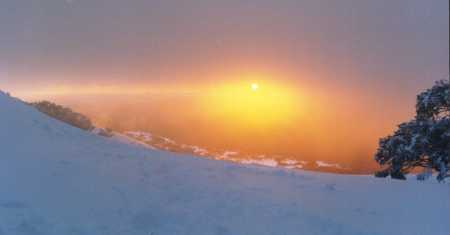 seems to cycle through bad, poor, medium and maybe fine if you are lucky, then back to bad. Well, that's what it feels like sometimes. But there are ways of handling it.
seems to cycle through bad, poor, medium and maybe fine if you are lucky, then back to bad. Well, that's what it feels like sometimes. But there are ways of handling it.
The High Country looks different when it is covered in snow - if you can see it, and this makes the navigation challenging. You try navigating across the High Plains in thick fog or a blizzard. And of course there are a few other traps as well. The funny thing is, we keep going back. There must be some reward. Maybe sunrise from the top of Gungarten?
Skis, Boots, Bindings etc
For travelling in the Australian snow country you have to get on top of the snow, and this means skis or snowshoes. You can try walking, but unless the snow is really firm this can be pretty desperate. Our snow is rarely firm enough that you won't sink in, maybe to your ankles or maybe to your knees. This gets very very tiring. But on skis you can glide across the top of the snow most elegantly ... Fall over? Of course not! I do remember one time when the Rolling Grounds were particularly awful, and one person decided to walk instead. Unfortunately she was above some boulders at the time, and when she stepped off the skis she sank through the snow and through the bushes between the boulders - just her head was left sticking up. Getting her out was not easy!

Normal cross country skis are different from resort skis. They come in two main varieties in Australia: back country touring and telemark. (There are other sorts overseas, like AT skis.) The touring skis are long, thin, light and are (usually) more flexible than resort skis. Some flexibility is very important: it allows the skis to bend under your weight as you try to turn. This is good: a curved ski is easy to turn. However, if they are too flexible they can break in the back country if you hit rough terrain. Skis at the other end of the spectrum have full-length metal edges and a "double camber", and are far stiffer. A classic example here are the old Bonner Conquests. They will survive some very rough treatment, but they won't bend the way you need for easy turning. On the other hand, they go faster than any other touring ski I have ever seen - in straight lines. You have to make the trade-off. We still have some Bonners, but have since moved on to softer skis with lighter boots and bindings. Hopefully they will prove just as robust against breakage. Yes, we have seen skiers shuffling back to civilisation with broken touring skis. They don't find progress very easy.
Touring skis usually have a region of "fish scale" in the middle: this allows the skis to grip the snow for going up hill. Without the grip region you have to put special waxes on the soles of the skis, and in Australia the variable snow conditions makes this a very poor option. Waxes are falling out of favour in the back country. Or you can use "skins" stuck to the underside of the ski, but relatively few do this today.
Telemark skis are far more solid, like resort or alpine skis. They have a similar three-pin binding here in Australia, but the boots are far more solid and high at the ankle. The new plastic XCD (extreme cross country downhill) boots look almost like the "Darth Vader" downhill boots. Really, these skis are for going down steep slopes and doing slalom-type skiing. They usually do not have a grip region. Many of them are now sold as "resort telemark" skis, and are meant for use with ski tows. This qualifies them as "yoyo" skis: the users go up and down the slopes on a piece of string. Climbing in smooth telemark skis is obviously more difficult: wax or skins are more useful here.
By way of comparison, downhill skis these days have a very large curve along the sides, called "side-cut". This makes the ski seem to have a bigger curvature and so turn more easily. Obviously this caters nicely for the once-a-year skier who has never learnt how to ski properly (said with a slight sneer). One might ask whether similar highly-curved edges could be used for touring. The answer is (unfortunately) no. To get any speed across flat country the skis must glide, and for this they need to be fairly long and narrow, with almost parallel edges. Well, not completely parallel - some side-cut is OK.
The second difference is the degree of flex in the ski. The old Bonner Conquest skis were not only straight, but also extremely stiff. They did not turn! More recent XC skis not only have a bit of side-cut, but they also have more flex. Combine a little flex with a little side-cut and you can turn!
You have to watch out for the terminology here. In Europe they have steeper country, not suitable for the Nordic touring skis. They need skis much closer to downhill or Telemark skis to handle their mountains and glaciers, but they still call it "cross country" skiing. They use safety bindings (usually called 'AT') on their "cross country" skis, very similar to those on yoyo skis. In fact, many European skiers, guides and ski shop employees have never heard of the Nordic bindings.
Now you have to attach the boots to the skis. Some tourers use a "three-pin" or "75 mm binding", also called a Nordic binding or a "rat trap". This requires a solid boot with a tab out the front, and usually a solid Vibram-style sole. Unfortunately, the basic rat-trap does not lock the heel of the boot to the ski, and this limits the force you can put on the ski to turn it. Turning the long touring ski is a mysterious art at the best of times. The connection can be improved with a Viole plate under the boot, but better is a cable binding on the back of the rat-trap. For more details it would be best to look at pictures of cable bindings such as the Riva brand. There are some new cable bindings by Rainey Designs on the market which do not have the actual three pins. Instead they have a bar over top of the tab and a cable around the back of the boot to hold the boot into the binding. They rely on the standard wedge angle on the sides of the tab. This design has the advantages that it is much easier to put the boot into the binding.
Others may have what is usually referred to as a Salomon or NNN binding, although there are actually several varieties and brands. This has a bar across the front and a plastic ridge under the boot. The ridge allows the boot to drive the ski sideways. The lighter versions are used extensively for skating, but there are now some heavier-duty ones (NNN-BC) which are suitable for back country touring. We have ([2009] switched from 3-pin bindings to NNN-BC bindings.
Ski boots come in a range of weights, from heavy plastic to solid leather to light "DV" style for skating. The very light ones only come with Salomon bindings. The author has only used the light Salomon bindings on skating skis once: comments from users would be appreciated. However, the NNN-BC bindings work well, and the boots are synthetic and much lighter than the old leather 3-pin boots.
For easy touring ski boots should not be very high at the ankle, and should be fairly flexible. After all, the range of ankle motion will be similar to that when walking, or even more. That is, the heels should be able to lift, but the boot soles must not twist. If they do twist it becomes extremely hard to make turns reliably, as the skis wobble. Unfortunately, leather boots are not that rigid. To solve this the vendors have introduced plastic-reinforced 3-pin boots, initially in the downhill field and now in the back country field. However, plastic boots are almost as rigid as the downhill boots, which means they are very cumbersome if you want to travel any distance. Incidentally, everything that has been said about the dangers of boots which are too small should be repeated here: tight boots mean cold feet and agony. You don't know agony until you have had frozen feet in the snow. (Actually, frozen hands are just as bad.)
I tried wearing some T3 plastic boots on touring skis for going some distance and found that the high reinforcing on the boots caused a lot of pressure and rubbing on my shin bones. This became unbearable after a few hours. Really unbearable! Perhaps if I had used the yoyo ski lifts and concentrated on skiing downhill instead of climbing the hills this might not have happened, but it did tell me that I should never try to use these boots in the back country. (I am not that stupid: we were testing them out on the Perisher Loops, and it was only a quick hobble back to the Lodge to change into some nice comfortable low-cut ski boots.) On the other hand, if telemark or alpine downhill are what you want, the plastic boots may be what you need.
At this stage the FAQ will not go into more technical details, but there are plenty of books on the subject, such as
"Australian Cross Country Skiing", Ian Hempil, Kangaroo Press, 1988 (covers everything, but a bit old fashioned)
"Free Heel Skiing", Paul Parker, Chelsea Green, 1988, (legendary telemark author)
Why do Skis Work?
Well, why do skis work? The simple answer used to be that the pressure of the skis on the snow makes a film of water, and the skis slid on that. But recently this idea has been called into question, and possibly rejected, so things are indeed a lot more complex, and we now have a page just on Melting Below Zero. However, further contributions are needed (you never admit that a research area is finished!).
Snow Shoes and suitable footwear

It used to be that in Australia you saw XC skis and only skis. Snow shoes were from a different land and just not used here. But that has been changing over the years, and now we have quite a strong support for the use of snow shoes, and we even have one snow shoe manufacturer - Yowie, in Melbourne. Skis do have a certain class and elan to be sure, and in the right conditions you can go quite fast and far on them, but in recent years it seems that global warming has stuffed the condition of the Australian ski fields, and it's either ice or slush. OK, a slight exaggeration, but we have been finding conditions better for snow shoes recently than for skis. In America there may be as many people going snow shoeing as go XC skiing. It is really popular. The European ski field now offer XC snow shoe trails as well.

Let's be a bit more explicit about the problem. In recent years we seem to be getting an increasing amount of wet snow in the afternoon which turns to ice overnight. Sometimes that makes for very fast but barely controlled skiing - which is not all that much fun when the inevitable high-speed crash follows. Other times it turns out that the ice is too thin, and is really 'breakable crust'. That means you may be going along fine for while, then the ice breaks and your ski sinks in below the ice layer. That doesn't sound too bad, except that it is then impossible to turn the skis if you have light boots and narrow skis. At the least you crash; typically you find your skis going off in different directions for a rather serious crash, and in the worst case the crash includes a badly sprained or even broken knee or ankle. It took over two years to get a full flex back into one sprained knee.
The author and his wife have used imported Northern Lights snow shoes and the locally-made Australian Yowies. Both are quite good. The experience of American snow shoe enthusiasts is that shoes like the lightweight Northern Lights are for real enthusiasts, while other brands like heavier Tubbs Adventure series are more for the tourist/novice, going on easy level ground. I think the radical design of the Yowies come as a bit of a surprise in the USA, although they do have some toy brands which are vaguely similar - a bit more like plastic tea trays though. No, the Yowies do not handle like tea trays!
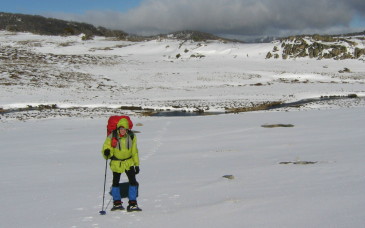
One outstanding advantage of snow shoes comes in that contentious area of weight. A pair of three-pin XC boots and a pair of XC skis weigh a huge amount - anywhere between 4.3 kg and 6 kg, per person. And you can only ski in those boots: don't try bushwalking in them back to your car. Been there, done that, suffered the pain and blisters. You will probably need to carry some light joggers as well. On the other hand you
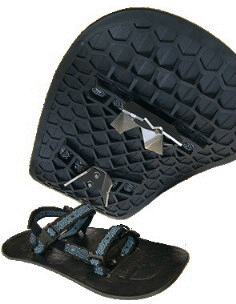 can use a pair of light joggers with snow shoes because of the simple versatile bindings, and the good snow shoes like the Yowies or Northern Lights Elite weigh barely over 1 kg per person. That's a huge difference in the cross country snow fields of today, where you can find yourself walking on grass of mud at times. You would be carrying your skis for sure, but we simply kept walking in the Yowies to where the snow started again. The mud and rocks didn't hurt the Yowies at all; they would have wrecked our skis.
can use a pair of light joggers with snow shoes because of the simple versatile bindings, and the good snow shoes like the Yowies or Northern Lights Elite weigh barely over 1 kg per person. That's a huge difference in the cross country snow fields of today, where you can find yourself walking on grass of mud at times. You would be carrying your skis for sure, but we simply kept walking in the Yowies to where the snow started again. The mud and rocks didn't hurt the Yowies at all; they would have wrecked our skis.
Do you need ski poles with snow shoes? I am using just one trekking pole here, and a lot of the time I had that stowed on my pack. Seriously: I was just walking. It's that easy - while XC skis can take years to learn, snow shoes take minutes. One reason is that have an excellent grip on the snow - in all directions, and the reason lies on the underside of the snow shoes. All good snow shoes have a sort of crampon on the underside. In addition, the Yowies have this hexagonal grid of ribs, and between the crampons and the grip they grip on anything. Boilerplate ice going up Jagungal? Stomp, stomp. Ice and powdery snow coming down Jagungal? I was running - yep, running in snow shoes with full control. Granted, there was a lot of snow flying up behind me, but on skis it would have been so slow, probably with crashes on the ice when I lost it.
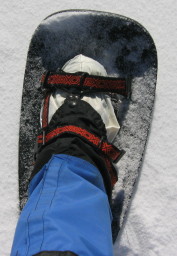
An excellent idea with snow shoes is to wear some very light overshoes with your joggers. You see, what happens so often when walking in the snow is that bits of snow end up sitting on your joggers, and because there is some warmth there from your feet the snow melts, and that water slowly dribbles into your socks. But with some light overshoes on this is blocked in two ways. First, much less snow accumulates on the smooth nylon fabric: it tends to slide off instead. There's not much snow on my foot here. And second, when the snow does melt the water runs off the overshoes and does not penetrate the shoe, making your socks wet and cold. The overshoes do not have to be very heavy to work: these were made of 70 denier proofed nylon. Of course, waterproof/breathable gaiters are a seriously good idea here too, and this is one place where the Goretex fabric shines.
Does that mean I was wearing light non-waterproof joggers on those snow shoes? Yep, just my ordinary light approach shoes, with some nice thick warm Darn Tough Vermont walking socks. Does it also mean I had comfortable warm feet all day? Yep, of course. After all, these are just my ordinary light walking shoes. On the other hand, some of those modern plastic ski boots are both agony and freezing, and even the older light leather ones are so heavy. And that brings up the third advantage to snow shoes: the cost. All it cost us was for the snow shoes. Granted, a pair of Yowies cost about $300 and the imported snow shoes cost a bit more, but that is chicken feed compared to what it costs to buy a full ski outfit: skis, binding, poles and boots. If you want to hire before you buy, you will find that hire costs for snow shoes are a corresponding amount less than for skis too.
Clothing
Everything which has been said about warm clothing in the clothing section applies even more so in the snow. The weather can go from hot to freezing with the passage of a cloud. The use of the layering principle is important, and so too is avoiding natural fibres like cotton and wool. Our snow country here is so often around 0C it can be hard avoiding getting a little wet at times, and these fibres just love absorbing water. The one exception is in socks, where the heavy wool/synthetic blends can be useful.
Carrying one (or maybe two) thermal tops is a good idea. The equivalent of a Polartech 100 shirt is also a good idea: even when it is sunny the air can be cold. Once the wind blows - wind chill can be savage. The top warmth layer is often the equivalent of a Polartech 300 jacket. Note that since this was first written, "they" seem to have changed the naming of the fabrics, and far more vendors are active in the field. In fact, fleece clothing is a boom industry, and rather nice to wear too. The good malden Mills stuff is not cheap, but Chinese stuff at the supermarkets is cheap, albeit not quite so good. Some people carry a "duvet" or down jacket. These have a construction similar to that of a sleeping bag, and are even warmer and lighter than a fleece jacket. However, they are not as robust, and a wet duvet can be a small disaster. For this reason many duvets are now made with a very light GoreTex or Epic outer shell, to reject snow and very light rain. However, they are not made for wearing under a pack either: the straps and the pressure at the back can ruin the down fairly quickly. If you carry a duvet instead of a Polartech 300 jacket you will probably need the extra thermal top for the daytime.

Long trousers are almost essential in the snow. But the snow is a funny place: when the weather is bad you want proper padded ski trousers: a synthetic full shell and synthetic padding. Forget the wool trousers: they never dry and wet wool gets cold when the wind blows. And remember that jeans are the last thing to ever wear in the snow: they get wet and you freeze. The author has seen hypothermia happen that way, and people have died that way too. But go ski touring on really sunny spring days and you will be surprised at what you see: bright skin-tight Lycra blossoms all over the snow. Actually the Lycra wearers are not being silly or (too) show-off about this. The Lycra fabric sheds the wind, protects you from the sun, is moderately warm (especially if double-layered), gets rid of sweat quickly and dries almost instantly. Check what all the ski-racers wear: the same Lycra. It performs. I went from wet to dry in about 5 minutes after rain on Mt Tate once in Lycra. The justification for the fluoro colours takes a little longer ... Search and Rescue maybe?
Also check the term 'shell wear' in the Rainwear section. Some of the new and very light breathable silicone fabrics (eg EPIC) make excellent outer layers in all conditions short of serious rain. I made a 'parka' out of very light Epic fabric and it worked very well in the snow. Macpac sell jackets made of this material too, albeit not seam sealed. However, while I did seam-seal the one I made, I am not sure that was really necessary now. If other vendors have similar products, please tell me.
Gloves, Mitts and Hats
Some form of hand protection for cold weather, and especially skiing, is absolutely essential. There are few pains as bad as frozen hands (but try frozen feet). The trouble is not the cold air, or the cold ski stocks, but the cold snow when you fall over, and the wet hands you get. It happens ... Again the layering principle should be used for best results. However, don't bother with the heavy padded leather ski gloves sold to downhill skiers: they get wet easily and are then pretty useless for warmth. In fact, gloves with fingers are generally a bad idea anyhow: the padding between the fingers tends to limit the circulation through your fingers. This is hardly smart. Try a light pair of synthetic liner gloves for sunny conditions, a heavy pair of synthetic mitts (Polartech 300 or thicker) for cold conditions, and some light waterproof overmitts to keep the wind off. GoreTex is good for overmitts: your hands can get very sweaty.
Overmitts are good for when you fall over: they stop your hands or mitts from getting instantly wet. Seam sealing would be nice for the overmitts, but is hard to find and is not essential. Only very heavy mitts seem to have it - mitts which are really designed for extreme ice climbing. These are expensive and a bad idea for touring: they are so stiff your hands get tired from just holding the ski stocks.
One reason that I am rather doubtful about seam sealing overmitts is that it can be a waste of effort. Imagine you have the cuff of the overmitts on the outside of your jacket. Any water on your arms will flow down inside the overmitts when your arms are lowered, giving you wet hands despite the wonderful fabric. If the cuffs of the gloves are inside the jacket the same applies when you raise your arms - only now it's your sleeves which get wet,. I think that is worse. At least, if you do get a bit of water inside your overmitts, it can be warm water.
A few other points should be made on top of the idea that gloves are much colder than mitts. Just as the pressure around the fingers restricts the blood flow through them, tight wrist seals on jackets and tight watch straps can restrict the blood flow through your hands. Your hands end up cold regardless of what mitts you have. Your wrist watch band may have been loose when you started, but after lots of arm exercise the muscles in your wrist will swell up. (It used to puzzle me why my left hand was always colder than the right hand.) Finally, it can be useful in the snow to have a tie line on your mitts. It's very sad when you see the mitt you just took off sailing away in the wind. I use a loop of hat elastic around my lower arm connected to another bit of hat elastic going to the glove. That is enough. The loop usually is at my wrist, inside the mitt, so there are no dangling bits of elastic to catch on things.
The final bit of clothing you will need is a warm hat with ear flaps. It helps if the material sheds the wind as well. When a storm gets going you will understand why, although you will probably notice the rest of your body getting cold first. There is an old snow country saying that if your feet are cold, put a hat on. Dr Phil Law, head of ANARE for so many years, used to say "A numb brain is a dumb brain, and only a dumb brain gets a numb brain". You can also take a balaclava, and at -15C they are nice to have, but in the Australian ski fields you are unlikely to ever really need one.
Snow Tents, and pegs
The first rule for the snow is that you carry a tent. Sure, you may be planning on sleeping in a hut somewhere. What happens if someone has an accident on the way, or the weather turns foul and you can't find the hut? Only recently (2004) a group of men nearly died when heading up a short spur to a nice big hut. They never made it, and tried to camp in the snow without suitable gear. If they had not been rescued that night at least one of them would have died. One winter time we were staying in Grey Mare Hut for the night (the weather was a bit filthy) and around 4 pm a group of very wet guys staggered in and collapsed. They had very foolishly waded across both the Valentine and Geehi rivers, got soaking wet, and then walked in the snow and wind to the Hut because they had no shelter with them. They did not even have the energy to make a hot drink on the fire we had running. (We did it for them). A couple of them were that close to dying imho. Carry some form of shelter!

This is where those heavy four season tents earn their place: out in the snow fields in a storm. Why a 4-season tent and not a lighter one? One good reason is that the inner tent you get in a 4-season tent is more or less a full wind-proof shelter in itself. When it starts to blow two things come into your tent. The first is cold air, and having a good "sealed" inner tent makes life so much more pleasant and warm. The second intruder is fine snow. It blows up under the edge of the outer tent, in through small gaps in over-lapped closures, and seems to drift everywhere. Unless the inner tent can really block that, you are going to have snow on your sleeping bag. A good definition of luxury: a fine hot dinner in the comfort of your 4-season tent while a storm rages outside.
The fabric of the inner tent obviously has to have a good DWR: it is quite common for the gap between the inner and outer tent to collect a lot of snow in a storm. Heat from your bodies can melt some of this. The water can drip down from the roof if the DWR on the inner tent isn't good enough. Of course, it helps to keep an eye on such things, and to knock the snow down if you see it building up at all. Those American 'double-wall' tents which use netting for the inner tent are just a joke: they are really just 3-season single skin tents with good insect proofing. Don't be fooled by them!
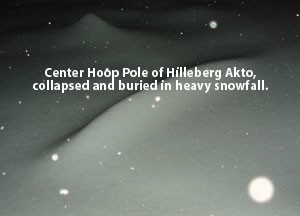
The next thing which comes with a good 4-season tent is a secure tent pole arrangement. Forget those tents where the poles are not threaded into the fly, or where the inner tent is hung from the free-standing poles and the fly thrown across the top. Sure, they are easy to pitch - in fine weather. Come a good wind and the tent shape will start to distort. Eventually the fly will slide across the poles, the poles will bend or buckle, and either the whole thing will collapse. Look at the single-pole 3-season tent shown to the left. Yes, there was a tent under that snow - somewhere. Or, worse still, the poles will snap. Oh yes, it happens. Ask at any bushwalking shop to see the bucket of broken tent poles they have out back. The damage some poles have suffered will really make you wonder. Serious 'expedition' tents often have room in the pole sleeves for double poles: that's some wind they are expecting.
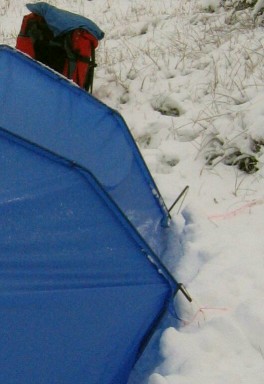
In some places you will have to pitch your tent in the open, especially on the major ridges. However, at least try to get some sort of wind-break for your tent. For a start, that gives you a better chance of still having a tent in the morning. It also gives you a much warmer night if the tent isn't flapping wildly. Camping in the lee of a good thicket of snow gums is good; inside the thicket at the downwind edge is even better. At the least you can build a bit of a wall around your tent to divert some of the wind. There was a bit of a howling storm during the night, but the snow gums in the picture to the above-right gave us lots of fine shelter. Camping in the lee of a large ridge can help, but you may well get hit by gusts all night. It was clocking about 100kph over Gungarten Saddle one night, and there were lots of gusts below. Our Olympus took it, but the dome next to us had real problems.
On the other hand, camping too close to a sharp ridge or behind a very large boulder can be quite dangerous. You might think that it will provide you with a good wind-break. Well, only up to a certain wind-speed. After that the wind starts to shed vortices into the sheltered space, and these come and hit your tent from all directions - including downwards. Now tents are usually designed to take a sideways wind, but in general they are not designed to take a wind slamming down from above. Poles get damaged this way. There is worse to come: sharp lee corners usually collect a lot of snow: that's how cornices form. So you may end up with a lot of snow on top of your tent - and that can overload the poles and collapse the tent. There is even worse again: if your tent has a good load of snow on it from being in the lee, then a vortex comes straight down to hit your tent, you can lose the lot as every pole in the tent breaks under the unexpected downwards load. Tents are just not made for a downward load you see.
In the picture here, taken of a 3-season tent in April in Kosciusko NP, the snow out in the open was only about 10 cm deep, but around the tent it was about 30 cm deep. It had been sunny the afternoon before, but the tent was pitched right against a sharp little bank. Snow had quietly accumulated on top of the tent during the night, then a vortex had come down, overloaded the lot and snapped poles everywhere. That was the first we knew it was even snowing.
To pitch a tent in the snow, first stamp out a flat tent site. It only takes two people about 10-15 minutes to do this, and it can be done on slopes as well as on the flat. A snow shovel can help except that it is so heavy: try a square of thin hard aluminium sheet about 200 mm square instead. A slight bend across the middle will stiffen it some more. This is used to shovel and scrape snow around. You should wear overgloves while doing this: bare hands will get wet and freeze otherwise. There is an interesting fact about snow which helps enormously with making a tent site. In the evening the temperature is dropping. When you stamp the snow down you jam the snow crystals together. They melt just slightly at the points of contact: see Melting Below Zero for details. Give the snow a few minutes after you have done the stomping and it all freezes together, helping to make a solid platform. It helps if you make the platform really horizontal, for obvious reasons. It also helps if you shallow out the centre just a little: it makes a "hip hole" and helps stop you sliding away as well.
Then you have to anchor the tent. Forget the little pegs that came with the tent: replace them with snow pegs. If you buy channels, get them at least 200 mm long and 30 mm wide, although 200 * 40 might be better (but heavier). Alternately, try square plates known as "deadman anchors", as shown below and in the Pegs and Guy Ropes page. Before you put the pegs in, stamp the snow down hard, and shovel more snow into the hole as well. You want a solid block of snow for the pegs, especially at the ends of a tunnel tent. Put the pegs right in: don't leave any sticking out. This means you might have to put the peg in most of the way, hook the guy rope over the top of the peg, then cover the lot with more snow. Yes, this can make it hard to get the pegs out in the morning if it was a cold night, but the tent will have stayed up.

Far worse is when it rains in the snow. Obviously if it is raining the water is above freezing point. The rain itself may not do much damage to the snow, but any warm wind with the rain will! If the top of the peg is sticking out into the wind, the peg will get warm and melt the snow around itself - and then be able to rattle out of the hole in the wind. Do not think I am kidding: I had to reseat the pegs twice in one night in 2003 when we had 36 hours of rain at well over 5C. How do I know it was the wind, not the rain? Because I noticed that if the top of the peg was hidden below the snow the melting was much less.
The worst case of all in the rain is when the peg is near the tent roof: the end pegs on a tunnel tent or the edge pegs on a dome for instance. The warm water from (almost) the entire roof flows down over the peg and literally melts a hole around the peg - or around the base of every tent pole. This is one case where the rain does do damage. The pegs fall out, and the tent poles sink into the snow; the tent can collapse. In cases like this you have only two good choices: retreat, or camp on the grass which is probably now showing through the snow. Other options include "dinner plates" under each tent pole (but think of the weight) and special pegs for the ends of the tent. I use square deadman anchors with a long string and hook, as shown in the diagram here, and I bury them too. At least the hole in the snow is some distance from the anchor. But even dinner plates are only partially effective in heavy rain: the snow melts under them.
Sleeping Bags and Mats
Naturally, with all that cold snow underneath you are going to need some sort of mattress. Foam mats are OK if thick enough, but a deluxe (thick) Thermarest is really good value for weight. Next morning have a look at where you slept: even with a thick mattress you will notice the centre region has sunk slightly, leaving a very comfortable hip hole. Sometimes, I think camping on the snow is more comfortable than on hard ground.
Need we add that camping in the snow will normally require a reasonably warm sleeping bag? However, conditions can vary. We spent one night on Mt Tate in the spring when we had to sleep on top of our winter bags for most of the night, but there was far less snow on the ground the next morning. There was a warm wind all night, and it must have melted at least 200 mm of snow off the surface - in that one night! On the other hand, we slept by the creek near Grey Mare Hut one clear night - right at the bottom of a frost hollow. A silly move: we should have been in the trees higher up. Next morning it was -17C outside and -15C inside the tent, and there was a thick layer of hoar-frost on the inside of the tent above my head. I know: I brushed it with my head as I sat up, and it showered down the back of my neck. That is the sort of night when you need a few tricks to stay warm.
The "warmth" ratings you see on bags have no Australian standard between manufacturers, so it is not much use quoting the ratings. However, there is now a serious European Standard, EN13537, which is reliable and reproducible, and even sensible. Unfortunately it costs about $5,000 per test to get your sleepng bag rated, and so far the Australian vendors have not bothered. It is interesting (or worrying) that some American claims came out about 15 degrees too optimistic under this standard - hum ...
You may need at least 700 gms of good high-loft down for the snow, assuming the bag comes from a good manufacturer, for the cold nights. Women may need a little more down as they often sleep colder than men. Of course, two people snuggled up together is much warmer! There are other ways to reduce the weight of what bag you need, as listed below.
Apart from the listed ideas, it may be worth while thinking of radical alternatives. These days my wife and I take our light summer sleeping bags (300 g of down each) to the snow, plus a quilt which is sized to cover the two of us, with 700 grams of down in it. That way each of us has a 'draft-excluder' of our own, but we share our warmth under the quilt and don't have as many exposed sleeping bag surfaces to lose heat from either. The total weight is 2,100 grams, while the weight of our two older winter bags is 3,360 grams. That's quite a big difference, and we are probably warmer. In practice we use our sumemr 'bags' as inner quilts too: they are warmer this way because they are not stretched at knnes and so on. Me, I just pull my head right under the hood of my sleeping bag and let the edges of the hood flop down all around me. With the light Pertex fabric I have no trouble breathing under it all.
While a good mat may keep you off the snow, that does not solve all your problems. You have to breathe out, and your breathe carries water vapour. Some of this will condense on the inside of the inner tent, and shower down the back of your neck in the morning, either as water or as ice particles. Unpleasant. Some of your breathe will condense on the groundsheet near your head. It may stay melted, which means the underside of your mat is going to get wet. This water will wet out the rest of the mat when you roll it up, and next night your sleeping bag will be on a wet mat. About the best solution here is to stuff spare gear, especially things like mat cover bags and sleeping bag covers, between the side of the mat and the groundshet. Hopefully the gear will be warm enough that your breathe won't condense on it. In theory you can limit the amount of condensation inside your tent by having lots of ventilation. Yeah, right! (Well, you can, but it takes a fine balance between ventilation and freezing.)
If you are out for many nights and you do manage to score a fine day, it may be worth while putting the tent up a little early to dry out, and to put your sleeping bag on top of the dry tent to air. The hot sun and low humidity will dry things quite well.
Tricks to stay warm in the snow
There are plenty of tricks to help you sleep warmer in the snow.
- If you are using a 3/4 length Thermarest, put some light foam (3-4 mm is fine) under your feet - and any spare clothing. The high pressure your heels exert can squash padding and down flat, and give you cold heels.
- A good dinner is essential of course. No food: no energy, no warmth. But skip the alcohol: it does not work and can kill.
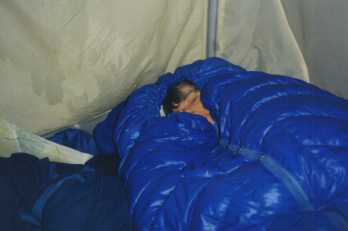
- Do up the hood around your head straight away: you may not think your head is getting cold, but that is the last part of your body which will feel cold: all the warm blood will go there if necessary, away from your feet. Keep your head warm and your feet will be warm too.
- You can also try sleeping with the hood on the top, pulled over your head. This is just as warm, but far less claustrophobic and the hood does not get dirty. You need a nice washable pillow instead, but that's easy to do.
- Use a good long silk liner inside your bag, and pull it right over your head when you get in. It will help keep your warm breath inside, warming you. It will also keep the inside of the hood cleaner, which helps.
- All that waffle you see in some catalogues about extra insulation for your feet is pure marketing spin based on ignorance. Cold feet usually means your head is taking all the blood supply away from the rest of your body. If your feet are cold, warm your head. Anyhow, adding extra insulation does not provide more warmth: your body provides the warmth.
- If you sleep on top of the hood, use the neck flap to stop cold drafts from getting in, and if necessary wear a thermal top for the same reason. But it is much better to sleep under the hood, and to use the down you have carried up the mountain properly. Women may benefit from thermal longs as well.
- Avoid any clothing which is tight: it restricts the blood circulation. Let your warm blood circulate! That applies to tight underwear like bras, by the way! Take them off in bed.
- If you want to carry a lighter sleeping bag, plan on wearing some of your warm clothing to bed. After all, if you are carrying this warm Polartech fluffy jacket, why not use it when you are cold? Some American ultra-light enthusiasts use a summer-weight bag and a duvet jacket for sleeping in the the snow. They are carrying the duvet anyhow, so they use it.
- Warm up the bag when you get in. Pull your head inside the bag and breathe down into it for about 5 minutes. You won't suffocate, but all that lovely warm breath will really get the bag warmed up. It's as good as a hot water bottle, but weighs nothing. This happens automatically if you have the hood on top.

- Take advantage of any sun to air your sleeping bag. After a few days of snow camping the down may be starting to get damp and losing its insulation. But bring the bag inside the tent as soon as the sun goes off it.
- Tent with someone you like. That way you can snuggle up to them when it gets really cold. Believe me, it works!
- Camp among trees rather than at the bottom of the valley in the "frost hollow".
- Camp where you can get the morning sun straight in the tent door. At least, it feels warmer!
- Forget about starting off at the crack of dawn. If there's sunshine, let things warm up a little, at least.
- Camp as much out of the wind as possible.
Frost Hollows
I mentioned the term 'frosty hollow' above. This is a technical term for the fact that the cold air in the mountains tends to collect at the bottom of the valley. That is why you see grassy valleys and tree-covered hills in our alpine regions: the extra cold is enough to stop the trees from growing in the valleys. Of course, it also means the botom of the valleys are cold places to camp. If you look at the picture here (Hell Hole Ck, March) you can see a frost layer across the valley and going up the hillside: it stopped when it reached the trees. And of course the valley is open, while the hillsides are covered.
Sunscreen
You will be skiing nearly 2 km above sea level. When the sun comes out the UV levels rocket to a deadly level, and they can be pretty high even under a cloud cover. This is one place where you must use good sunscreen, frequently, and a suitable hat. Under really extreme conditions we have even resorted to wearing a silk scarf across our faces, just under the dark glasses. It may look funny, but we didn't get burnt. For the same reason, we keep at least light gloves on our hands at all times.
(The author is biased: he has spent some years working on the detection of skin cancer: malignant melanoma. It's real, and it's nasty.)
Sunglasses
The same arguments apply to your eyes as to your skin. You are high, and the sunlight is strong. It can seriously damage your eyes. Wear sunglasses or goggles which give 100% blockage of UVA, UVB and UVC. In Australia good wrap-around (certified) dark glasses seem to be adequate for many people, but at higher altitudes goggles may still be essential (if only to keep the wind from drying your eyes). Incidentally, some contact lenses now claim to provide a 100% block to UV light, but this only applies to the centre of the eye. The retina may be protected, but the edges of the eyeball are still completely exposed. This is not adequate!
You may think that snow blindness is only caused by the UV light (I certainly did). An article by Black Ice (Australian makers of certified sunglasses selling below $20) in the August 2003 Snowy Times claims that visible light can also cause snow blindness. According to the article, Black Ice claim that excess visible light can cause your eyes to take a (painful) break for 48 hours, and that they will make a full recovery. According to the article, this damage is different from that caused by the UV. They pointed out that you get the excess light because of the increased altitude and the nearly 100% reflection off the snow. This means that sunnies which offer 100% UV protection but little darkness (eg yellow ones) are not going to protect you from this form of snow blindness. It also means that carefully chosen $20 sunnies (ie ones with a certified UV rating, like the ones Black Ice sell) will be just as good as $200+ fashion brands. I always thought some of those fashion sunglasses prices were too high.
However, while excess visible light may cause some eye problems, this does not mean that UV radiation is safe. It isn't: the UV hazard is very well known, and is probably more severe. John Shannon , MD, sent me this URL for the damage which UV can do to your eyes: http://www.emedicine.com/emerg/topic759.htm. It seems fairly comprehensive and convincing. Of course, it's up to you how much care you take of your eyes: are they worth $20-30?
Food and Fuel
Never mind the glamorous pictures of fit young ladies gliding effortlessly around in scanty clothing. Ski touring overnight means a fairly heavy pack, and can be hard work. So you will need to increase the amount of food you take. Two excellent additions are a good quantity of cocoa and maybe some extra Two Minute Noodles. Extra chocolate biscuits are needless extravagance of course, just like custard and dark fruit cake.
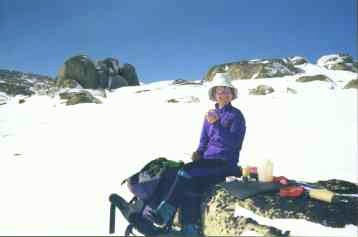
Some changes in foods stuffs may be in order too. If the weather is fine lunch in the snow can be delightful. If the weather is less than perfect at lunchtime you may find that stopping to spread butter and jam on biscuits is not really all that attractive. It pays to have some sweet biscuits in the lunch menu for those times when the sleet is laying it on. Get them out and stick them in your pockets to eat as you crawl along. What you must not do under those conditions is go without lunch: you will need the food! Mild problems from insufficient food include headaches, feeling run down and grumpy, and doing silly things. The worst result of not eating enough can be hypothermia (and death). It happens!
We find that we use about 20% more fuel in the snow because the water starts off so much colder, and we have a few extra drinks and so on. Even so, on recent snow trips we have been using only about 40 g of gas a day. But see below as well.
Just for general interest we have included an article from BackPackingLight.com on a short snow trip in America here. It illustrates the extra load a snow trip places on you. However, please read the RNC notes at the bottom: some aspects of what they were doing are not recommended for safety reasons, and some ideas seem a bit extreme or just wrong.
Water
Less well understood is the amount of water you will be breathing out. That cold air is really quite dry, and you can lose water very quickly. Current thinking is that High Altitude Mountain Sickness may be induced by dehydration. "Too much effort to melt snow and make a drink: we won't bother". Bad mistake: make sure you drink enough - extra soup, coffee, tea or cocoa is a good idea.
In principle you don't have to worry about finding water when ski touring. However, melting snow uses a bit of fuel (and is slow), so it is worth while spending quite a bit of time and effort finding running water. How much extra fuel you take (above the 20% mentioned above) in case you have to melt lots of snow is up to you: better to err a little on the safe side. Baling the water out from the bottom of a snow hole can be tricky, but a larger hazard is falling through the overhang on the edge of a large creek. People have nearly died this way. Filtering this water is essential to eliminate the usual hazards from bugs. (Water from Whites River below the Whites River Hut should be filtered, boiled, sterilised and then discarded imho. The comment about 'Whites River Waltz' by K A Moylan at the start should not be ignored. )
Also watch out for coloured snow. You will find all sorts of colouring on the snow at times: yellow, red, brown... Yellow holes are obvious; the others are often either algae or dust. Yes: pink snow can be due to algae. Odd coloured lumps on the snow have turned out to be bits of animal left by the foxes. It is safest to go for clean white snow. It is usually not necessary to filter clean snow you have just melted.
Some people find it hard to drink really cold water, and to some it gives tummy aches. This can be a problem, and it may be worth while warming up your drinks just a little bit. That does not take much fuel. Of course, if you warm it up a bit more you have a nice warm water bottle to take to bed ...
Navigation
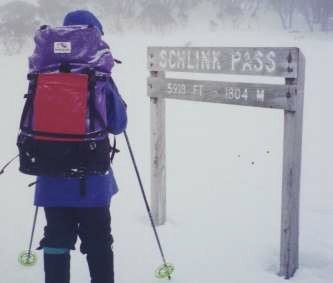
The hills look different when covered in snow - if you can see them through the blizzard. You will need to watch your compass more carefully most of the time, and especially when the weather is bad. Very experienced people have been known to travel at right angles to where they thought they were going, and even climb steep mountains they did not mean to climb (ahem). Under poor conditions (soft, wet or sticky snow) you will travel more slowly than expected as well. Even if you are making very visible tracks, do not rely on them being visible a couple of hours later for the return trip if the weather is bad. We have seen spindrift (light loose snow blowing across the surface) mask tracks very quickly even in fine weather: 5 minutes and the traces were gone.
On the other hand, it can be disconcerting to come across old tracks running at right angles to what you think is the right direction. In spring some tracks can last for ages, even remaining above the general snow level. "Where were they going?" can be an amusing riddle; "Did they know where they were going?" might be just as applicable.
In bad weather it might be better to camp early, in the hope that tomorrow will have better weather and you can see where you are. Allow some extra time for this in your plans. At least, if you have to stop where you are, you will have water! Apart from that, experience is the teacher, but start out cautiously.
Another navigation problem you can meet are the creeks during the thaw. You might be surprised to find that the little creek you saw in the summer is now a deep wide torrent. Kiwis know about river crossings: people die each year in them, but in Australia we do not have much experience with them. In August 2003 at the peak of the snow season the author found easy ankle deep crossings had risen to 1.5 - 2 metres deep, and were going very fast. We could not cross to go home, and had to wait a couple of days before we could get out. You will need to include plans for dealing with such challenges - and some spare food too.
Toilet
Frankly, the usual rule of burying everything gets difficult in the snow fields. Some books blithely emphasise the need to dig a hole 150 mm deep in the soil without admitting this is impossible when there is two metres of snow on the ground. Bury it in the snow of course, but remember that the snow will melt in the spring. If there are trees or bushes around, try to be amongst them so the mess will at least disappear into the scrub when the snow melts. Of course, if you are near one of those little pit toilets the Service has installed, try to use it instead. There are some rather elegant ones around (Valentines Hut comes to mind). However, at the time of writing the author is not game to use the Whites River Hut loo for fear that either the seat or the floor (or both) will collapse.
In some frequented areas like around Kosciusko or near a ski resort a large party might want to consider the use of a portable toilet made with a large PVC tube and a plastic bag - a sort of "crap and carry" arrangement. It can be done, but this is beyond this FAQ at this stage.
Igloos and Snow Caves
Most of us use tents in the snow, but you can also use snow caves and igloos. They have the advantage of being almost immune to howling storms; they have the disadvantage of requiring 2-4 hours of labour to build.
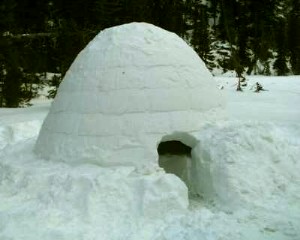
A snow cave is made by picking a large area of deep snow with a steep front, such as the side of a windblow or near-cornice, and burrowing in. The floor slopes slightly uphill so any CO2 will roll out the door, and there should be a small hole in the ceiling as well for ventilation. You tunnel in towards the hillside, then fork sideways in both directions, a bit like a "T" with the door at the bottom of the upright. You make a narrow walkway with sleeping benches on either side, and a bit of a table area for eating. The doorway is usually blocked with packs or similar, to reduce the drafts. A word to the wise: you should bring one or two ski stocks inside to maintain the vent hole, and the shovel to dig your way out if there is a big snow fall. The author's experience of caves is confined to inspecting some collapsed ones, so we need a couple of good references or write-ups, and some pictures.
Then there are Igloos. Since these are such a specialised topic it seemed reasonable to put the rest of the info on its own Igloos page. They do have considerable advantages of space and stability, but they need special tools (which are available) for building and they take severla hours to buld.
Batteries in torches & cameras
There's a sad little secret about ordinary alkaline batteries in the snow. They don't work. They die in a few minutes.
Actually, the truth is a shade more complex. The problem lies with the battery chemistry. Most forms of batteries stop working below 0 C: the electrolyte inside them starts to freeeze. You turn your torch on with fresh batteries and in a few minutes the batteries seem dead. Or you go to take a photo and nothing happens.
There are two things you can do about this. The first is obvious: keep your batteries warm. This may mean you keep your camera inside your clothing: that's fine as long as the rather high humidity there doesn't damage the camera. With large SLRs this can be awkward of course: they don't fit inside jackets and they do suffer damage from humidity. Or you can keep just the battery pack in your clothing.
The second possibility is to use Lithium batteries, which have a different chemistry from the alkalines. There are several sorts giving different voltages; the Lithium/Iron Sulphide ones match an alkaline cell for voltage and can replace them. The Energiser ones (formerly e2, now something else) are typical. These do work quite well below 0C, down to -40 C in theory. The Energiser AA and AAA batteries are readily available in Australia, and it seems that Eveready are also releasing similar batteries. There may be other brands of AA lithium battery available, but I don't know what they are. Lithium batteries are a bit more expensive, but some of them make up for their high price by having a far greater capacity. You can also import them from America, where some of the brands seem extremely cheap. How good they are I know not, but I suspect you get what you pay for.
If you switch to one of the LED torches you will get much better life from your batteries any time, and especially in the snow. The reason is the far lower current drain the LEDs require compared with tungsten/incandescent globes. A small incandescent may be pulling 500 mA; a LED torch may pull a mere 25 mA depending on the model. (The ones with 1 W white LEDs pull a lot more, but they are excessive for camping.) Cold batteries can manage the lower currents much more easily. Also, the very small LED torches can be kept inside your clothing quite easily: this is recommended.
BackpackingLite have several technical articles on LED technology for torches; they are worth reading. Some of them require a paid subscription, but others are for free. The one entitled 'LED Lighting Technology...' also has a useful table of batteries (but reading it requires a subscription).
Obviously we need some more technical details here. I will research, but if anyone wants to contribute here they are welcome.
Clubs
NSW Nordic Ski club.
The cost [2002] was about $25.00 for individual. This entitled you to the club magazine and participation in instructionals ($40 per weekend) with APSI qualified instructors, and in any trips the club is running. They run trips for any level, beginners to advanced. See http://members.ozemail.com.au/~nordski/
Canberra Cross-Country Ski Club
It costed $25 to be a single, local member [2002]. Things they have: an organised ski touring program, generally 3 tours every weekend, of varying difficulties; a lesson program for members, ranging from basic skills to telemarking & racing skills; twice monthly social meetings during the ski season; other club stuff, e.g. newsletters, longer trips, big social events. The web site starts at http://www.cccsc.asn.au/ .
© Roger Caffin 1/3/2002, 22/08/2010


 seems to cycle through bad, poor, medium and maybe fine if you are lucky, then back to bad. Well, that's what it feels like sometimes. But there are ways of handling it.
seems to cycle through bad, poor, medium and maybe fine if you are lucky, then back to bad. Well, that's what it feels like sometimes. But there are ways of handling it.



 can use a pair of light joggers with snow shoes because of the simple versatile bindings, and the good snow shoes like the Yowies or Northern Lights Elite weigh barely over 1 kg per person. That's a huge difference in the cross country snow fields of today, where you can find yourself walking on grass of mud at times. You would be carrying your skis for sure, but we simply kept walking in the Yowies to where the snow started again. The mud and rocks didn't hurt the Yowies at all; they would have wrecked our skis.
can use a pair of light joggers with snow shoes because of the simple versatile bindings, and the good snow shoes like the Yowies or Northern Lights Elite weigh barely over 1 kg per person. That's a huge difference in the cross country snow fields of today, where you can find yourself walking on grass of mud at times. You would be carrying your skis for sure, but we simply kept walking in the Yowies to where the snow started again. The mud and rocks didn't hurt the Yowies at all; they would have wrecked our skis.









